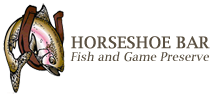I often get asked what fly to use and where to fish the at the club. The truth is there are fish everywhere. Any place you decide to fish will have good numbers of fish there. Getting the fish to take your fly is another matter. Frankly having the right fly is the second most important factor in being successful. The first is having a dead drift. Without that, it does not matter what fly you use. You will get a dead drift by mending correctly.
Mending: The fish quickly see that a fly is not floating naturally and will not take an unnatural fly. So when you see fish rising and not taking your fly it may be because you do not have a dead drift. You might have the right fly. Here are some suggestions that might help you. Your leader and tippet must be long enough so that when you mend it does not move the fly. I use 9’ leaders and add several feet of tippet. When I am using two dry flies the farthest fly is 12’ to 15’ from the fly line. These long leaders and tippet allow for a better drift. When you go to mend you need to have enough line out to allow you to make the maneuver with your rod tip. Below are some tips to help you mend. By the way, I look at debris , bubble and anything else on the water to judge my drift. Also recognize that there are numerous rates of flows across the same place on the river. You should be fishing the seams. The fish will hold in the slow water and feed on the food in the faster water within a few feet of where they are holding. Below are some tips I took off the web.
1. Anglers Wait Too Long to Mend
Everyone deserves props when a perfect cast is made, but don’t make the mistake of admiring it, and forget to follow it up with a good mend. Most often, but not always, a fly angler should make their first mend within a second or two of the fly landing on the water. Why you ask? Because it’s the most critical mend of your drift. It sets up your entire drift, and will eliminate the need for extra mending.
2. Anglers rod tip does not travel high enough in the air during the mend
The majority of the time when mending you’re trying to mend as much of your fly line and leader without moving your flies. The longer the cast or more fly line you have on the water, the higher you’ll need to move your rod tip in an oval shape path. “Give me a superman mend”, I say to my clients, when their mending a bunch of fly line. What I’m meaning by this is giving me the biggest mend you can.
3. Anglers mend their line by moving their fly rod in a sideways motion instead of upside down u-shape or n-shape (“C” shape)
When your mending, your trying to pick up fly line and leader off the water and reposition it (placing it back down upstream or downstream of your fly). I see a lot of anglers moving their rod sideways in a straight line when mending. All this does is require you to mend again seconds later.
4. Some drifts require multiple mends
Even a perfect first mend isn’t always enough to get you through the entire drift drag-free. Sometimes fly anglers will need to mend two, three, and even four times from the beginning to the end of their drift. I see a lot of people fall behind on their timing of their second and third mends. Be ready for it, and as soon as you start seeing a loop forming to the left or right of your fly, commence mending. When done properly you’ll extend your drag-free drift and will be less likely to move your fly on or below the water surface.
5. Strip excess fly line in between mends
Mending your fly line you will at times build more slack up between you and the fly than you want. Too much slack and you’ll have a hard time setting the hook, but secondly, too much slack will make it very difficult to execute you next mend.
6. Be prepared to change mending direction during the drift
Eddies and converging currents downstream of your fly may require you to mend in the opposite direction of your first mend during the later parts of your drift. Don’t feel like there’s only one correct direction to mending your line. Pay attention to the direction of where the loops of your fly line are forming and mend the opposite direction.
7. When dry fly fishing you have to be more subtle with your mending.
Just about anyone can make great mends when their nymphing with a strike indicator. The weight of the rig and friction of the surface provides us with a buffer that keeps it from moving during mending. When your dry fly fishing though, you don’t have that buffer, and fly anglers need to take a more subtle and slow approach. Don’t be overpowering or in a rush, instead raise your rod up high smoothly and make a tight half-circle path with your fly rod to finish the mend. This should do a good job of keeping your dry fly from moving on the water’s surface.
8. It’s ok to lift your fly or strike indicator off the water during your first mend.
A lot of novice fly anglers think it’s bad to move your fly or strike indicator with the first mend. Most of the time it’s not a bad thing at all, and can make your drift even better. I do it all the time when I’m deep nymphing in fast water, where even the slightest loop in my leader or fly line will hurt my drift. When I’m dry fly fishing, I often will cast just past my target, so when I make the big mend, it will pull the fly slightly back to me and drift in my target zone.
I hope this information will help you become more successful.
Tom Bartos
President & Founder


Leave A Comment
You must be logged in to post a comment.